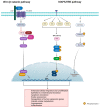Current Advances in the Management of Adult Craniopharyngiomas
- PMID: 35323338
- PMCID: PMC8946973
- DOI: 10.3390/curroncol29030138
Current Advances in the Management of Adult Craniopharyngiomas
Abstract
Craniopharyngiomas (CPs) are slow growing, histologically benign intracranial tumors located in the sellar-suprasellar region. Although known to have low mortality, their location and relationship to the adjacent neural structures results in patients having significant neurologic, endocrine, and visual comorbidities. The invasive nature of this tumor makes complete resection a challenge and contributes to its recurrence. Additionally, these tumors are bimodally distributed, being treated with surgery, and are followed by other adjuncts, such as focused radiation therapy, e.g., Gamma knife. Advances in surgical techniques, imaging tools, and instrumentations have resulted in the evolution of surgery using endoscopic techniques, with residual components being treated by radiotherapy to target the residual tumor. Advances in molecular biology have elucidated the main pathways involved in tumor development and recurrence, but presently, no other treatments are offered to patients, besides surgery, radiation, and endocrine management, as the disease and tumor evolve. We review the contemporary management of these tumors, from the evolution of surgical treatments, utilizing standard open microscopic approaches to the more recent endoscopic surgery, and discuss the current recommendations for care of these patients. We discuss the developments in radiation therapy, such as radiosurgery, being used as treatment strategies for craniopharyngioma, highlighting their beneficial effects on tumor resections while decreasing the rates of adverse outcomes. We also outline the recent chemotherapy modalities, which help control tumor growth, and the immune landscape on craniopharyngiomas that allow the development of novel immunotherapies.
Keywords: chemotherapy; craniopharyngiomas; gross total resection; minimally invasive; molecular biology; neurological complications; radiation therapy; sellar tumors; surgical resection.
Conflict of interest statement
The authors declare no conflict of interest.
Figures







References
-
- Ostrom Q.T., Gittleman H., Liao P., Vecchione-Koval T., Wolinsky Y., Kruchko C., Barnholtz-Sloan J.S. CBTRUS Statistical Report: Primary brain and other central nervous system tumors diagnosed in the United States in 2010–2014. Neur. Oncol. 2017;19:v1–v88. doi: 10.1093/neuonc/nox158. - DOI - PMC - PubMed
Publication types
MeSH terms
LinkOut - more resources
Full Text Sources
Medical

